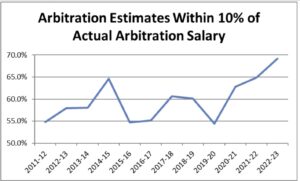For the first time in a half-decade, the Red Sox enter a season with questions about who’ll take the lion’s share of playing time behind the plate. Christian Vázquez has been their Opening Day starter in each of the last five years. His trade to Houston at last summer’s deadline and subsequent three-year free agent signing with the Twins ensures Boston will have to find a new solution in 2023.
The Sox currently have just two catchers on their 40-man roster. Boston brought in Reese McGuire in a trade with the White Sox just hours after shipping Vázquez out last August. The former first-round draftee finished the season well, hitting .337/.377/.500 with a trio of home runs in 36 games with Boston. It was an excellent first impression for the 27-year-old (28 tomorrow) but an outlier in the broader context of his career. In 566 plate appearances between the Blue Jays and White Sox prior to the trade, McGuire had hit .241/.286/.359 with only nine longballs.
McGuire hasn’t had many consistent opportunities to get into a groove against MLB pitching. Before last season, he’d never appeared in even half a team’s games. He’s generally had a strong defensive reputation, though. McGuire has rated as an above-average pitch framer in each of the past two seasons, per Statcast. In just under 1600 career innings behind the dish, he’s thrown out a very strong 31.4% of would-be basestealers.
Connor Wong looks like the early favorite to split time with McGuire at Fenway Park. The other catcher on the 40-man, he’s only played in 33 big league games over the past two seasons. Part of the Mookie Betts trade return from the Dodgers, the 26-year-old Wong has put up an impressive .276/.327/.471 line in 131 games for Triple-A Worcester. That included a particularly strong .288/.349/.489 showing with 15 homers across 355 plate appearances for the WooSox last season.
There’s reason for optimism regarding both McGuire and Wong, though there’s obvious risk in relying on either as a regular considering neither have proven themselves over a full season against MLB competition. McGuire hits left-handed and Wong swings from the right side. That’d seemingly raise the possibility of mixing and matching based on pitcher handedness, though manager Alex Cora pushed back against that this afternoon. “It’s not a strict platoon situation,” Cora said (link via Peter Abraham of the Boston Globe). “Wong can hit righties, too, and Reese can hit lefties. We’ll see how we do it. We’ll see what the roster is and we’ll make decisions.”
The Sox shied away from any significant catching additions this offseason. Boston didn’t add anyone on a major league free agent deal or via trade. Former Marlin and Padre Jorge Alfaro was brought aboard via non-roster pact. Alfaro brings some more experience to camp and looks like the top depth option in the organization. That he was limited to minor league offers this winter hints at the strikeout and defensive questions that have dogged him throughout his career. Alfaro is a .256/.305/.396 hitter with a 34.1% strikeout rate in parts of seven MLB campaigns. He has excellent arm strength but typically posts below-average marks as a receiver.
Former top prospect Ronaldo Hernández and Caleb Hamilton, claimed off waivers from the Twins at the start of the offseason, are also in the organization as non-roster players. Each has upper level experience but has gone unclaimed on waivers this winter and seems clearly behind McGuire and Wong on the roster.
It’s possible Boston looks to augment the catching depth before Opening Day, perhaps by targeting a veteran currently on a minor league deal elsewhere but who doesn’t crack an MLB roster. The Guardians, as one example, have each of Cam Gallagher, Meibrys Viloria and Zack Collins on non-roster pacts battling for a backup job this spring. Gary Sánchez is the top remaining free agent catcher. However, Jon Heyman of the New York Post reported last week the Red Sox hadn’t had any contact with their longtime division rival.

